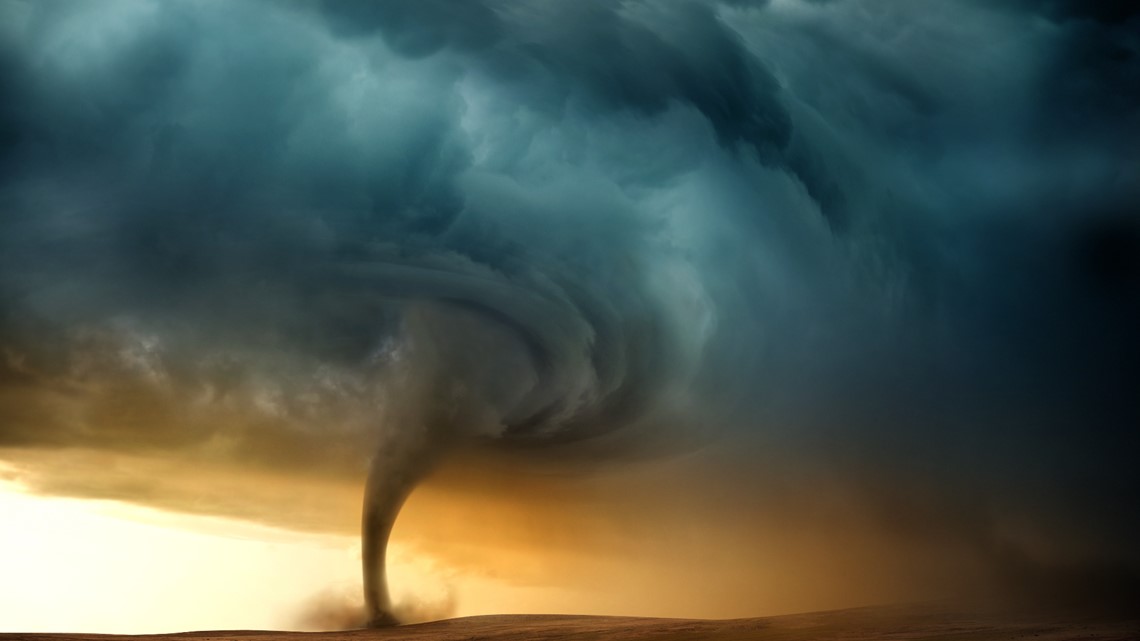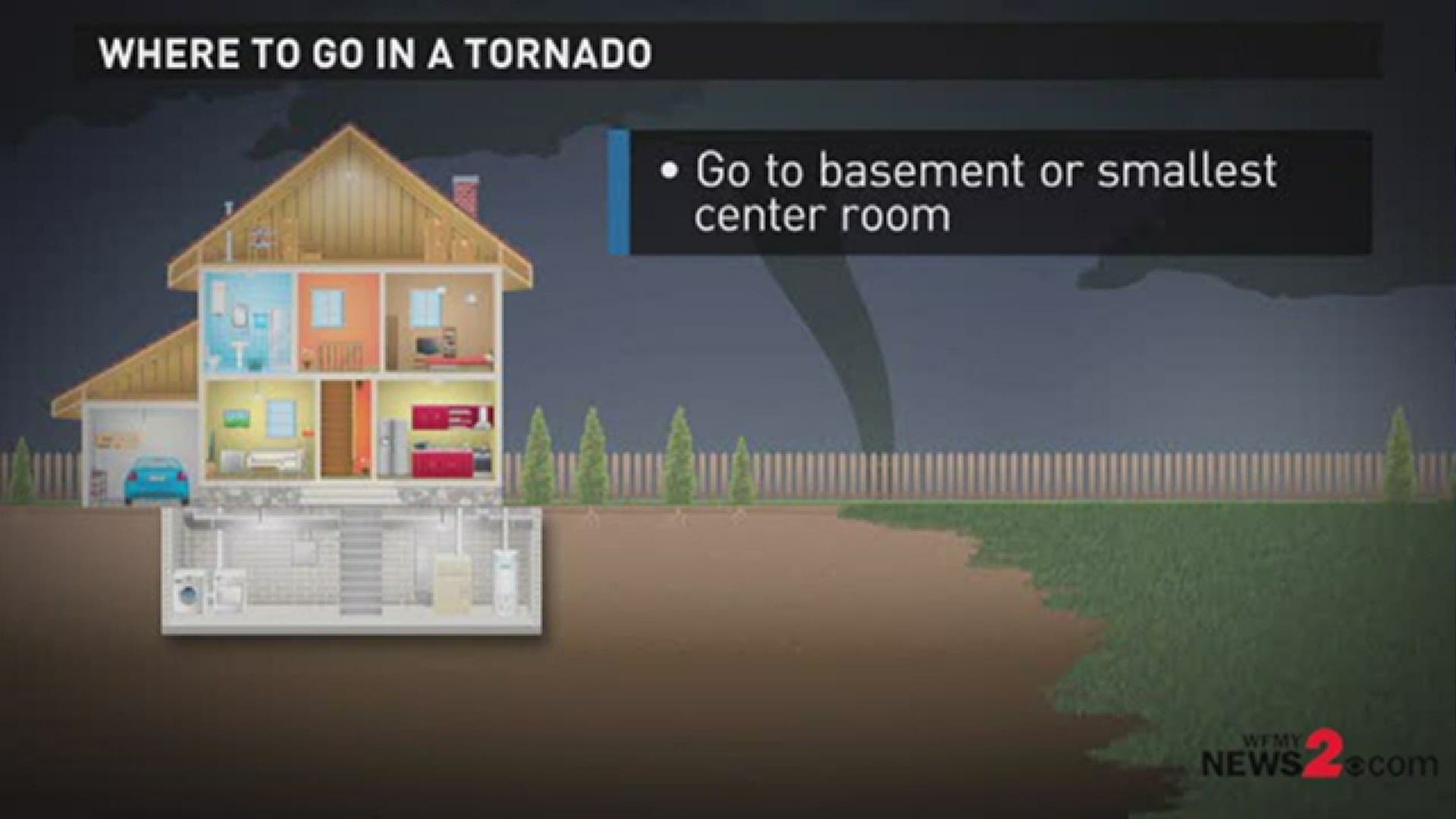GREENSBORO, N.C. — About 1,200 tornadoes hit the U.S. yearly, according to the National Weather Service.
Tornadoes are spawned from strong, severe thunderstorms and not only cause devastation but can kill those in the pathway of destruction. North Carolina averages about 28 tornadoes per year.
Tornadoes are most common between March and June in our state, but they may occur any time of the year. Hurricanes also spawn tornadoes.
How does a tornado form?
A tornado appears as a rotating, funnel-shaped cloud that extends from a thunderstorm to the ground with whirling winds that can reach 300 miles per hour, in the strongest ones.
Some tornadoes are clearly visible, while rain or nearby low-hanging clouds can obscure others. In some instances, tornadoes can develop so rapidly that little, if any, advance warning is possible, making them even more dangerous.
It's important to have a plan and to know where to seek shelter in the event of a tornado. Here are some safety tips, that could keep you and your family safe during a tornado.
BEFORE A TORNADO
- Be alert to changing weather conditions.
- Listen to NOAA Weather Radio or to commercial radio or television newscasts for the latest information.
- Look for approaching storms.
- Identify a safe location before a storm including at home, at work, or even out shopping.


WHAT IS A TORNADO WATCH?
A Tornado Watch means conditions are favorable for tornado development. People located in and around the watch area should keep an eye toward the sky and listen to their NOAA weather radio or turn to WFMY News 2 for further weather information.
The watch is intended to give you time to prepare and review your safety rules in the event of a tornado.


WHAT IS A TORNADO WARNING?
A Tornado Warning means that a tornado has been detected by the National Weather Service Doppler radar or a reliable report of a tornado has been reported from the field by a weather spotter.
A tornado warning is usually issued for portions of one or two counties for an hour or less. The storm could also produce large hail and destructive straight-line winds. If the tornado warning includes your neighborhood or workplace, you should seek safe shelter immediately.


LOOK FOR DANGER SIGNS
- Dark, often greenish sky
- Large hail
- A large, dark, low-lying cloud (particularly if rotating)
- Loud roar, similar to a freight train
- If you see approaching storms or any of the danger signs, be prepared to take shelter immediately.


DURING A TORNADO
- If you are under a tornado warning, seek shelter immediately.
- Get indoors to a pre-designated shelter area such as a basement, storm cellar or the lowest building level. If there is no basement, go to the center of an interior room on the lowest level (closet, interior hallway) away from corners, windows, doors and outside walls.
- If in a vehicle, trailer or mobile home, get out immediately and go to the lowest floor of a sturdy, nearby building or storm shelter.
- If unable to get indoors, lie flat in a nearby ditch and cover your head with your hands. Be aware of potential flooding and flying debris.
- Never try to outrun a tornado in your vehicle. Instead, leave the vehicle immediately for safe shelter.
HOUSE/STAND-ALONE BUILDING:
- Get to the lowest level possible.
- Go to an area with as many walls between you as possible.
- Get in a bathtub or interior closet.
- Protect yourself from flying debris with pillows, heavy coats, blankets, or quilts. Use bicycle or motorcycle helmets to protect your head.


MOBILE HOME:
- Leave your home well in advance or the approaching severe weather.
- Get out of the mobile home and get in a sturdy building if possible.
- If you can get to a building, get out of the mobile home and hunker in a ditch.
- Lay flat, covering your head with your hands for protection.
- If no ditch or building is nearby, plan ahead and get to a sturdy building ahead.
APARTMENT:
- Get to the lowest level (go to a neighbor's apartment on the first floor).
- Regardless of what floor you're on, get in a bathtub or interior closet.
- If you are on a higher level and can't get to a lower apartment, hunker down in the breezeway of the apartment building.
- Protect yourself from flying debris with pillows, heavy coats, blankets, or quilts. Use bicycle or motorcycle helmets to protect your head.
CAR:
- If possible, pull over, park, get inside a building and out of the storm.
- If you have to stay in your car, try to find a ditch to park in and use your emergency brake.
- Lie in an area noticeably lower than the level of the roadway and cover your head with your arms and a blanket, coat, or another cushion if possible.
- If your vehicle is hit by flying debris while you are driving, pull over and park, and cover your head with your arms and a blanket, coat, or another cushion if possible.
- DO NOT park under a bridge or overpass.
- Never try to outrun a tornado.


KEEPING SAFE
- Cover yourself with a mattress, sleeping bags, or pillows.
- Wear a helmet to protect your head.
- Hunker down as much as possible.
WHAT TO DO AFTER A TORNADO
Tips provided by Ready.gov
- If you are trapped, do not move about or kick up dust. Tap on a pipe or wall or use a whistle, if you have one, so that rescuers can locate you.
- Listen to local officials for updates and instructions.
- Check-in with family and friends by texting or using social media.
- Watch out for debris and downed power lines.
- Stay out of damaged buildings and homes until local authorities indicate it is safe.
- Use extreme caution during post-disaster clean-up of buildings and around debris. Do not attempt to remove heavy debris by yourself. Wear protective clothing, including a long-sleeved shirt, long pants, work gloves, and sturdy, thick-soled shoes during clean-up.
- Photograph the damage to your property in order to assist in filing an insurance claim.
- Do what you can to prevent further damage to your property, (e.g., putting a tarp on a damaged roof), as insurance may not cover additional damage that occurs after the storm.
- If your home is without power, use flashlights or battery-powered lanterns rather than candles to prevent accidental fires.
POWER LINE SAFETY
Safety Stay away from power lines that have fallen or are sagging during a storm.
Consider all lines energized as well as trees or limbs in contact with lines. Report downed power lines to your local power company and to your police department.
If a power line falls across a car that you're in, stay in the car. If you MUST get out of the car due to a fire or other immediate life-threatening situation, do your best to jump clear of the car and land on both feet. Be sure that no part of your body is touching the car when your feet touch the ground.

